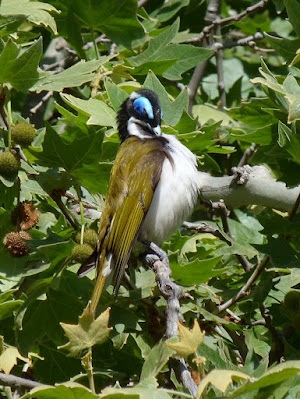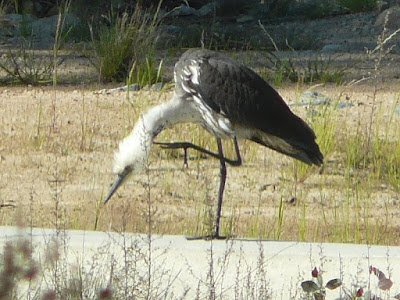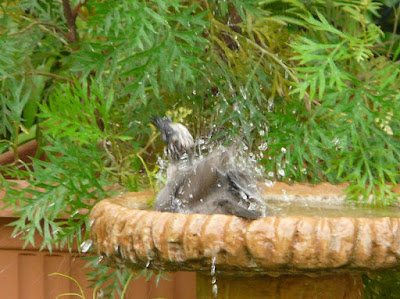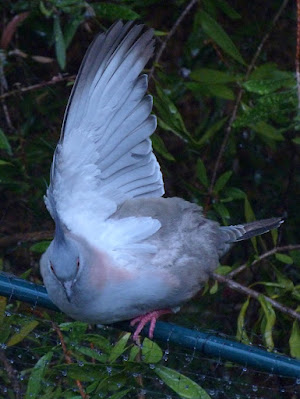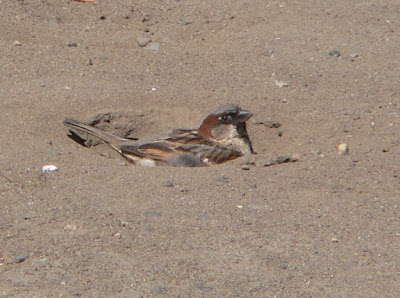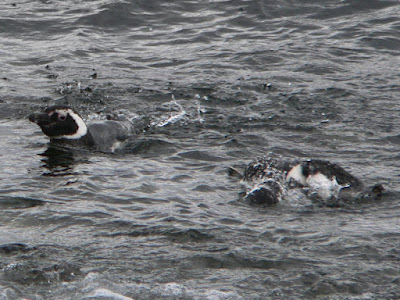This is a fully revised version of a blog I posted years ago,
with lots of new photos and updated information and taxonomy.
Well, in Australia dragons rule anyway. Of perhaps 350 species of dragon lizard (ie the Family Agamidae) in the world, around 110 are native to Australia, which is a very high level of diversity by world standards. Their origins go back at least 90-100 million years, as evidenced by fossils from across the globe, from south-east Asia to North Africa to South America. Despite this, dragons are no longer found in the Americas, but occur across Africa (and
slightly into Europe), Asia and Australia. Agamidae is a
'sister' family to the iguana family (Iguanidae) of the Neotropics and
some of the Pacific and, strangely, Madagascar. It's a funny thing, but
this rather odd distribution of the iguanas neatly fits into the gaps
left by the dragons; where dragons are, iguanas aren't, and vice versa. We can't explain it, but the situation is mirrored almost exactly by the two families of large constricting snakes, boas and pythons - presumably coincidentally, but it's quite a coincidence!
It is suggested that dragons (along with most other now-dominant groups of lizards and snakes) arrived in Australia about 30 million years ago as Australia drifted close enough to Asia for ocean rafting and island hopping to permit sea crossings. This is quite plausible of course, but it's not clear from the paper if DNA work exists to support the suggestion.
 |
Gippsland (Eastern) Water Dragon Intellagama (formerly Physignathus) lesueurii, National Botanic Gardens, Canberra. This handsome male in his confident prime is showing most of the characters
which immediately distinguish the family. These include strong clawed legs on which
he stands clear of the ground, and rough, even spiny, scales which don't overlap each other.
The tail is long and whiplike, and doesn't regrow if severed (unlike a skink's for instance). |
 |
For a really whippy tail please meet the Northern Two-lined Dragon Diporiphora bilineata,
here at Litchfield NP, south-west of Darwin. (This is a tricky genus, with ever-increasing numbers
of species recognised, but thanks to Steve Holliday I think I've got this right. However it could
also be Yellow-sided Two-lined Dragon D. magna. Any comments welcomed!)
|
 |
This Central Bearded Dragon Pogona vitticeps, Windorah, South-west Queensland,
was too cold to run away - the usual defence of dragons - allowing a good view of its spiky scales. |
For comparison, here's a large skink of similar size demonstrating the basic differences; people are often uncertain as to which is which, but you can pick them with a bit of practice. However there are certainly some fairly smooth dragons (like the Northern Two-lined Dragon above) and some skinks with prickly tails. The postures though are pretty definitive.
 |
Blotched Bue-tongued Lizard Tiliqua nigrolutea, Namadgi National Park,
in the ranges above Canberra. Like other skinks this is lying on the gound, with small,
fairly weak, legs and small claws. The smooth scales overlap at the edges, which
is better seen on the photo below of the same cooperative model.
|
|
Their family is so old that, while we regard them as lizards,
they (and the iguanas) are less closely related to other lizards than
snakes are. One character not visible in the pictures above is the
teeth; dragons have acrodont teeth, which means they don't have sockets,
but are fused at the base to the surface of the jawbone. It's a common
feature in fish and frogs, and isn't a very secure system, as teeth
break easily. This doesn't mean they don't work perfectly well, and
incautious handling of a wild Beardie left me quite efficiently
lacerated on more than one occasion in my rash youth.
Nearly all dragons (and all Australian ones) lay soft-shelled eggs. She
buries them - there may be as many as 30 - and leaves the young to
burrow out again.
 |
Southern Angle-headed Dragon Lophosaurus (was Hypsilurus) spinipes laying eggs in a
rainforest track, Lamington NP, Queensland. I've only been lucky enough to see this event
just this once, and a long time ago, hence the indifferent picture which is a scan of a
faded old slide. |
And in a sort of segue, here's its close relation from rainforests much further north.
 |
Boyd's Forest Dragon Lophosaurus boydii, clinging to a tree trunk by Lake Barrine,
Atherton Tableland, north Queensland. We'd walked here before without seeing one,
but this time we went in January, the rainy season which most visitors avoid, and
we had the best wildlife experiences we'd ever had there. Loved this one!
|
On those long legs, most dragons can run at astonishing speeds,
even rising onto their hind legs to do so. One group of Australian
dragons is known as 'bicycle lizards' for this behaviour!
 |
Crested Dragon or Bicycle Lizard Ctenophorus cristatus, west of Norseman, Western Australia.
Note the very long powerful hindlegs for running upright. |
There is also the hint of the bright brick red on this dragon which will
characterise him as breeding begins. This too is typical of many
dragons.
 |
Painted Dragon Ctenophorus pictus, Cape Bauer, South Australia.
The handsome blue flush will spread to his face when breeding starts. |
 |
Gippsland (Eastern) Water Dragon Intellagama (formerly Physignathus) lesueurii,
National Botanic Gardens, Canberra; only old males attain these striking colours.
There is a healthy population of these beauties adorning the gardens.
Like many dragons these lizards climb well, but they also swim powerfully,
dropping from a branch into the water if disturbed. (Mind you, this particular population
doesn't get disturbed easily - they will come to outside tables at the
restaurant hoping for dropped scraps!) |
 |
Rainbow Agama Agama agama,
Douala, Cameroon. Only the males attain these superb colours,
and only
when breeding. At other times they are dull brown, as are females all
year round.
There is an apparently healthy population of them on the footpaths and open spaces,
including petrol stations, in this huge crowded and polluted city. |
This is the genus (Agama) on which the Family name Agamidae is based. Curiously it comes from a Creole word in a Suriname patois, meaning simply 'lizard'. It's curious because this is an African group, not represented in South America. Ironically the word itself appears to have been brought from West Africa by slaves who ended up in Suriname and used the word for local lizards, but the name was then incorrectly applied by European taxonomists to a mishmash of American and African lizards! In the end it seems that an African one was the first one named, so they remained as Agama while the American ones got different names. (Actually the story is even more murky than that, but that's enough of it as the lizards are more interesting!)
Male agamas are famously colourful.
 |
Blue-headed Tree Agama Acanthocerus atricollis, Queen Elizabeth National Park, Uganda.
Breeding male above, and female (or possibly non-breeding male) below. |
And yet another superbly colourful African agama, this one from Tarangire National Park, Tanzania.
 |
Kenyan Rock Agama Agama lionotus making himself at home on the paths and steps of
our lodge. He's lost the tip of his tail (and as noted earlier, it won't regrow); there are
several potential culprits, including a bigger male agama and the local mongoose gangs.
|
 |
Augrabies Flat Lizard Platysaurus broadleyi, Augrabies Falls NP, northern
South Africa. This dragon lizard is very localised but abundant on the walls
of the gorges and around the waterfalls of the Orange River as it flows
through the dramatic stony landscape. The males are very colourful and
huge numbers of them can be present almost underfoot, but when we were
last there in 2019 drought was strong and numbers were low.
|
As just suggested, dragons can be very sociable, and interactions are common.
 |
| Agamas in open-air restaurant, Waza NP, northern Cameroon. |
 |
Gilbert's Dragon or Ta Ta Lizard Lophognathus (formerly Amphibolurus) gilberti,
Bladensburg NP, Queensland. The curious alternative common name comes from its habit of
'waving' to rivals, as this one is doing, to indicate that it is in its territory and aware of neighbours. |
This Gilbert's Dragon is a young one and wouldn't dare to actually challenge an adult male, which are very handsome and imposing lizards, like the one below.
 |
Gilbert's Dragon, Fogg Dam, Northern Territory.
|
Like the little Ta Ta Lizard above, many dragons perch high to watch for both danger and prey - all are carnivores.
 |
Bearded Dragon Pogona barbata, Temora, New South Wales. The name often starts with
Eastern to distinguish it from the five other Pogona species found throughout Australia.
They can adjust the melanin-bearing cells in the skin to turn almost black to absorb extra sunshine. |
 |
This Bearded Dragon in the National Botanic Gardens, Canberra,
has not only brought the melanin to the surface, but flattened itself and
turned side-on to the sun to maximise energy absorption.
|
These Bearded Dragons are common throughout eastern and south-eastern Australia, from Eyre Peninsula to Cairns, and are almost certainly the most familiar dragon to most Australians. Another common one is smaller and probably less obvious, but will certainly be known to many people around the south-east coast and fairly well inland.
 |
Jacky Lizard Amphibolurus muricatus, Currarong, south coast New South Wales.
Like the Bearded Dragon it is often seen perched up off the ground on stumps or logs.
It is distinctively patterned and very fast.
|
Jacky Lizards are very common in coastal heaths, which are generally good lizard habitats. Here's another heathland dweller, from higher in the ranges than the Jacky Lizards go.
 |
Mountain Dragon Rankinia diemensis, Blackheath, Blue Mountains, NSW.
|
Our understanding of dragon relationships (as with most other animal groups) has improved rapidly and dramatically in recent times with extraordinary new tools for looking right into their DNA, and the name changes are ongoing, including recognition of new species. The Mountain Dragon for instance was until recently included in the genus
Amphibolurus with the Jacky Lizard but is now known to be quite distinct, with no other members of
Rankinia.
I'm not sure when the name 'dragon' was applied to them, but it may well have been following Linnaeus' application of Draco (ie 'dragon') to the wonderful genus of 40 species of gliding lizards in south-east Asia. They glide long distances on membranes supported by extended ribs - I don't have a photo of them in action, but it's worth doing a quick search online, as they really are pretty wonderful. Here's a couple of species from Malaysian Borneo; sadly they weren't interested in showing off their skills while we were watching.
 |
Horned Flying Dragon Draco cornutus, Batang Ai, Sarawak. If you enlarge the photo,
you can see on its side the pleats of the folded gliding membrane. The throat pouch,
or dewlap, is a transparent membrane used by displaying males.
|
 |
Sumatran Flying Dragon D. sumatrana, Gomantong, Sabah.
Again you can see the folds of the gliding membrane if you enlarge the photo;
note the beautiful camouflage too!
|
While in Borneo we might as well meet another local dragon, a truly beautiful tree-dwelling lizard.
 |
Green Crested Lizard Bronchocela cristatella, Gomantong.
This is a common and widespread lizard in south and south-east Asia.
The one below is from Sepilok, also in Sabah.
|
Here's another African agamid, from Oldupai Gorge in Tanzania (often incorrectly rendered as Olduvai), the famous archaeological site associated with very early humankind.
 |
I think it's a female Mwanza Flat-headed Rock Agama Agama mwanza, the adult males
of which are brilliantly blue and pink-red, but I'd be glad of any assistance. They were
common around the excellent interpretive centre, on and by the paths.
|
And another African arid land agamid, this one from north of Maroua in northern Cameroon.
 |
I confess to an ulterior motive in including it here, in that I'm hoping someone
might be able to help me identify it! |
Back in Australia, one of the most famous dragon lizards is the
Frill-necked Lizard Chlamydosaurus kingii of tropical Australia, not to be confused with the Bearded Dragon, though the names are often interchanged.
 |
Frill-necked Lizard, Mareeba Wetlands, northern Queensland.
Spectacular, but not very often seen by visitors as they tend to be only active in the wet season,
when fewer people visit. In the dry winter they spend time in semi-torpor in trees. A Frill-necked
Lizard used to adorn the Australian two cent piece back when they existed.
|
Also from the Top End, another tree-climbing dragon, though one without the cachet of the famous Frill-necked. The wonderfully monikered Swamplands Lashtail Tropicagama temporalis is found across the tropical north from the east Kimberley to Cape York. This one was in a bush alongside the bird hide at Mamukala Swamp, Kakadu NP.
 |
Swamplands Lashtail, seemingly flaunting the magnificent tail.
(Again my thanks to Steve for assisting with this one.)
|
It is often said that Australia's great lizard diversity is founded on the abundance of termites in arid lands and termite mounds are key dragon habitat.
 |
Tommy Roundhead Diporiphora australis, Mareeba, Queenland, on termite mound.
|
But it's in the vast arid sweeps of the inland, on the plains and in the ranges, in woodlands and on dunes, that the dragons really come into their own. They are one of the numerous attractions of the 'outback' for me, and I'd like to end this little Dragons 101 offering by introducing a small selection of these tough, charismatic little desert characters.
 |
Slater's Ring-tailed Dragon Ctenophorus slateri, East MacDonnell Ranges, Northern Territory.
This is a good example of the way new genetic tools are revealing previously unconfirmed
species diversity. Where there used to be only one Ring-tailed Dragon recognised across
much of the desert country, now there are four.
|
Ctenophorus is the biggest Australian dragon genus, with some 34 species; we've already met three of them here, and here are three more, all at home in arid situations.
 |
| Spotted Military Dragon Ctenophorus maculatus, Lake Logue NR, Western Australia. |
 |
Central Military Dragon Ctenophorus isolepis, Great Sandy Desert, WA.
These little dragons were common in the dunes of this great desert, darting between spiny
spinifex clumps. Feral cat tracks were widespread but these speedsters could
apparently mostly evade them. They are found in most of Australia's deserts.
|
 |
Eastern Mallee Dragon Ctenophorus spinodomus, Gluepot Reserve, South Australia.
This one was only named in 2019, and is a specialist in mallee scrubland with spinifex.
(And it would not move from the annoying grass blades in front of it!)
|
A couple more bearded dragons, before the familiar Eastern Beardie hogs all their limelight.
 |
Central Bearded Dragon Pogona vitticeps, near Coober Pedy, northern South Australia.
It was a cold windy day and this character really didn't have the energy to run away.
It is found in a vast range across inland eastern Australia from north-western Victoria
to the Northern Territory central deserts.
|
 |
Western or Dwarf Bearded Dragon Pogona minor, Lesueur NP, Western Australia.
Despite the minor and Dwarf names, at up to 40cm long it's not that small,
though smaller than the Eastern Bearded Dragon. Its inland western distribution
almost exactly complements that of the Central Beardie.
|
 |
Gibber Earless Dragon Tympanocryptis intima, Bladensburg NP, Queensland.
These heat-lovers can be remarkably well-camouflaged against coloured desert stones.
These wind-smoothed stones, known as gibbers, washed from eroding hard caps of surrounding
hills, and cover vast plains in parts of the inland.
|
Finally, one of the most extraordinary dragons of all, which I first encountered decades ago crossing a busy highway on the Nullarbor Plain - I moved it far from danger but that was long before digital cameras. I've not seen a wild one since!
 |
Thorny Devil Moloch horridus, Desert Park, Alice Springs.
Surely one of the most extraordinary of all dragons; despite appearances, a slow,
harmless ant specialist. A little more information about this fascinating animal here. |
I hope you can love our dragons as much as I do - they're much more interesting and appealing than Smaug or the Games of Thrones crew!
I
love to receive your comments and in future will be notifying you
personally by email when a new posting appears, if you'd like me to. All
current subscribers have been added to this mailing list and have
already been contacted. This will mean one email every three weeks at the current rate of posting. I promise never to use the list for any other purpose and will never share it.
Should you wish to be added to it, just send me an email at calochilus51@internode.on.net. You can ask to be removed from the list at any time,or could simply mark an email as Spam, so you won't see future ones.
Thank you!




